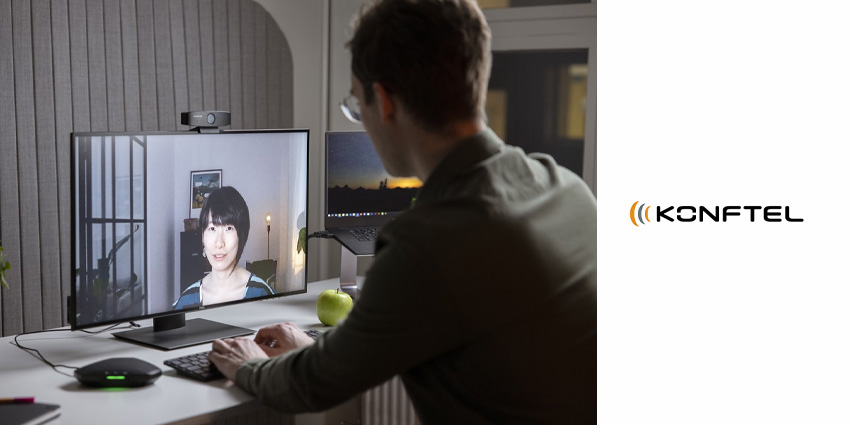You instinctively know when something is going right.
It’s a feeling. A sense of order and synergy.
But, in business, it’s more comforting still to have some real research to help inform your choices.
Two years on from the forced explosion in video conferencing, enterprises are testing its impact against three criteria: efficiency improvements, productivity gains, and revenue.
And – as evidenced by new research from global strategic advisory experts Metrigy – those who have embraced the technology most effectively are now seeing significant returns on their investment.
So, just what are the secrets to success?
And, just as importantly, how do those stats stack up?
“High quality video conferencing capability is business-critical and we are now seeing exactly why that is,” says Stefan Eriksson, Chief Marketing Officer at global collaboration endpoints giant Konftel.
“The hybrid working model is now firmly established and there is no going back. The smarter enterprises are leveraging the opportunities that brings.
“Embracing that new culture can be a tricky challenge but the rewards are now there to see.”
Konftel – who invented the first conference phone call more than 30 years ago – are perfectly-qualified to provide tips and advice.
It predicts a continuing increase in hybrid working: a revolution that will inspire growing demand for higher quality endpoints.
And it believes that many organisations will create a new ecosystem with a central office used to host clients, foster inspiration and facilitate collaborative sessions; complemented by virtual interaction via flexible working and meeting options.
In its view, the most successful companies will:
- Provide employees with a choice of work location
- Provide them with more video and audio devices to work from home
- Deploy video to all or most physical office meeting rooms
- Use video for most meetings and see it as critical business technology
- Consider the ability of meeting rooms to support multiple meeting apps of high importance
- Refresh meeting room AV equipment every three years
“Three years ago, many organisations had just one audio-only desktop conference phone and no video conference capability at all,” says Eriksson.
“Ease-of-use and user confidence has massively increased over that time, as has the number of popular collaboration platforms.
“That means it is important to use flexible, vendor-agnostic hardware that works across those multiple platforms and which is both easy to use and set-up too.
“But the main message is that quality counts.
“The better the quality of device, the better the return on investment.”
Metrigy concurs.
Its latest 160-page report on hybrid working – based on almost 400 global enterprises with mean annual revenue of $1.4 billion* – identified a ‘success group’ that is experiencing above-average cost savings, revenue increase and productivity gains derived from investments in high-quality collaboration technology.
More effective collaboration, more efficient meetings, increased project capacity and reduced travel expenses are some of the many benefits achieved.
Just over 70% of these ‘most successful companies’ saw value in equipping employees with high quality endpoints
Almost 60% of the group use video for most meetings and 45% of all companies surveyed say they have seen an increase in video use over the latest three month period.
Successful companies are also less likely to view the office as a place just for work, but also a collaboration hub for meetings and face-to-face interaction.
The research also highlights how increasing video use inspires greater success, with higher levels of video use in all meeting rooms and wider levels of general deployment.
“Organisations looking to maximise the impact of video conferencing may need to reconfigure and re-equip their meeting rooms,” says Eriksson.
“We have developed a room guide to help guide them in that process.
“It is also now completely ubiquitous for people to use their own devices to access the apps and collaborative tools they have come to prefer.
“So, we have developed a Bring Your Own Meeting blueprint to help ensure people enjoy the same familiarity and confidence regardless of the platform they are using or the meeting they are joining.
“Finally, organisations should be planning for video conferencing to play even more of a role going forward so the ability to easily expand their systems is key.
“All of Konftel’s technology is modular and can grow with their needs; from performance upgrades to reorganised rooms.”
Not that successful hybrid working is ALL about the tech.
People play a huge part too and it’s important to recognize what change means for individuals.
As transition accelerates, consulting with staff, keeping them engaged, and planning ahead is vital.
“All of this is part of the journey,” says Eriksson.
“Of course it is important for organisations to progress at a pace which suits them but it is now clear that video conferencing – and the quality of the equipment – is one of the key drivers of long-term growth.
“That means the time to act is now.”
*The Unified Communications Management and Endpoints report 2021-22 has been produced by strategic advisory analysts Metrigy. The study highlights successful methods for supporting remote, in-office and hybrid collaboration.
To learn more about how Konftel can help your and your customers’ business thrive in the hybrid workplace, visit www.konftel.com.







